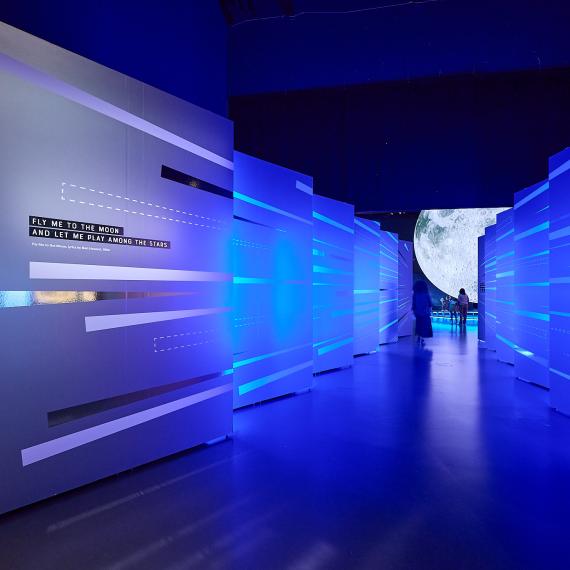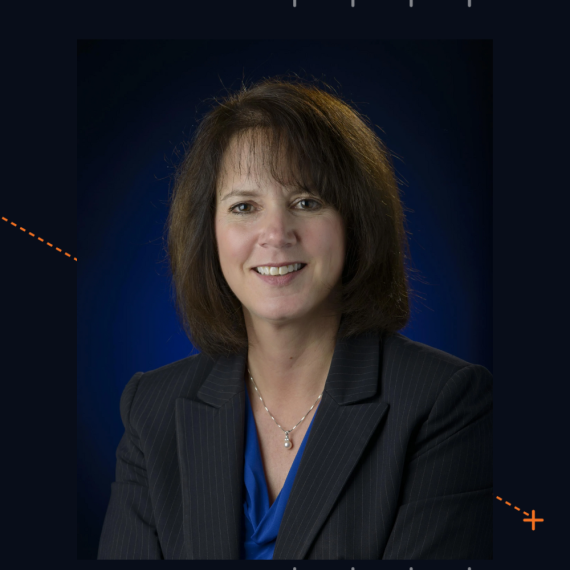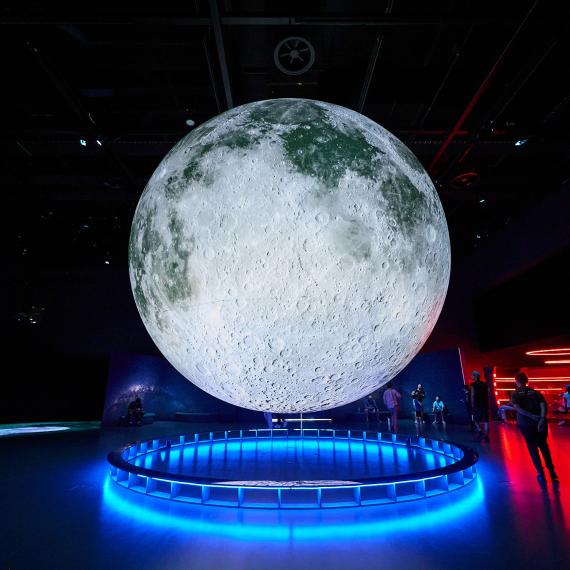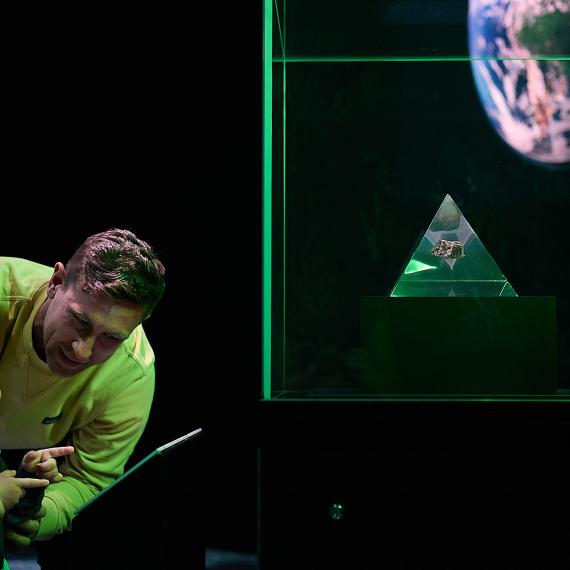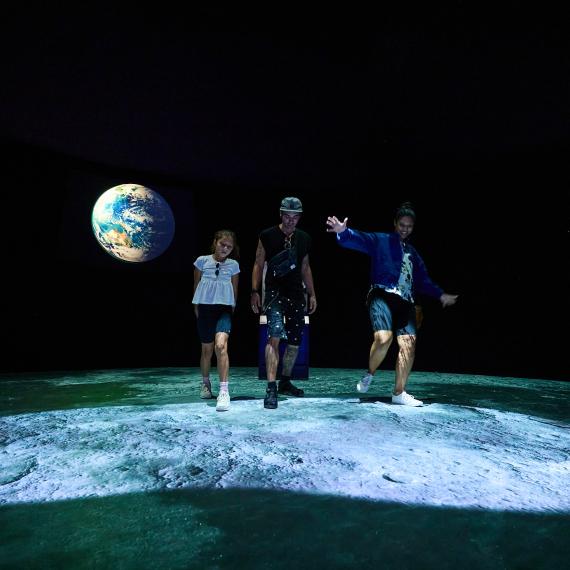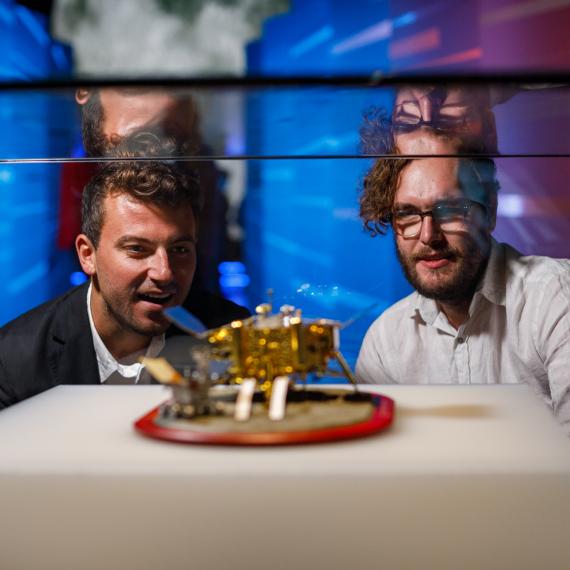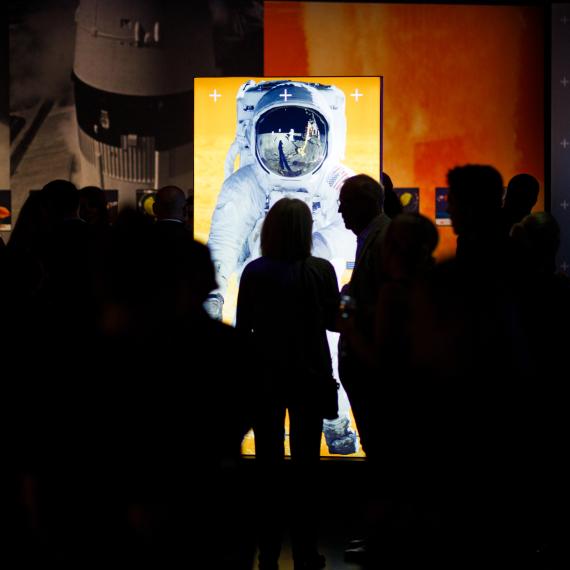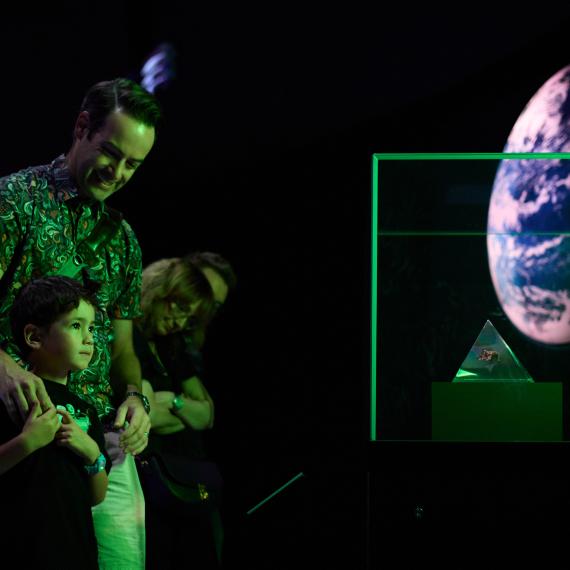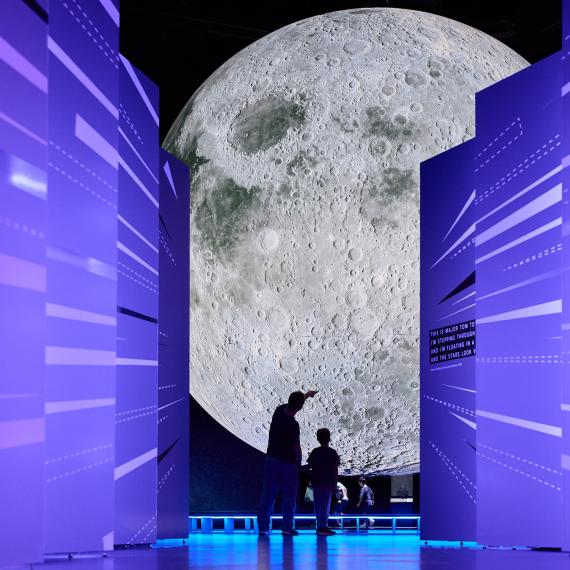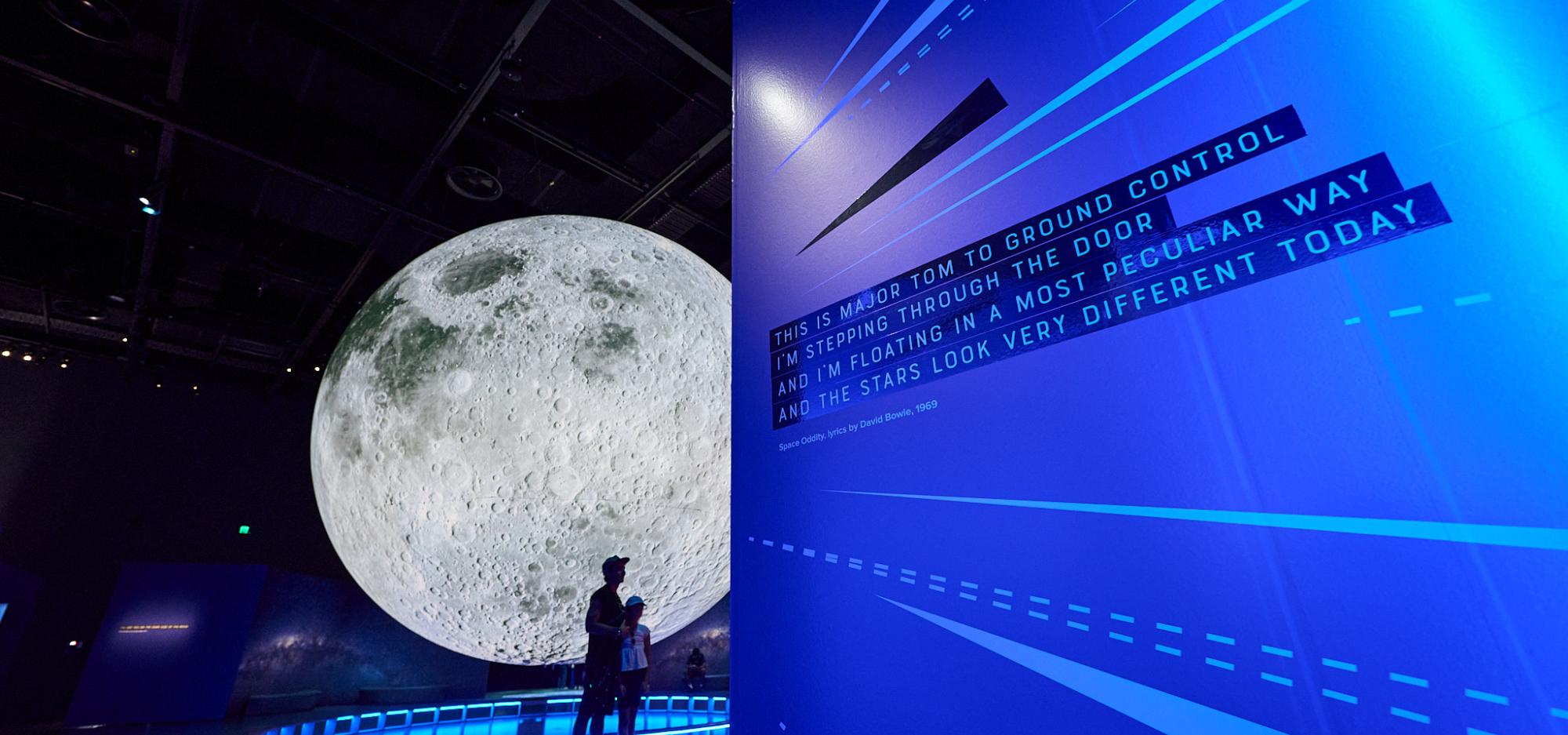
Multi-messenger Astronomy and the New Era of Cosmic Exploration with Professor Eric Howell.
Join Professor Eric Howell in this talk that delves into the heart of multi-messenger astronomy, highlighting its potential to decipher the intricate mechanisms driving these cosmic phenomena.
In the vast expanse of the universe, cosmic phenomena like gamma-ray bursts emit signals across multiple messengers - from electromagnetic waves to gravitational waves, offering us a unique window into the most energetic and enigmatic events in the cosmos.
The field of multi-messenger astronomy uses these diverse signals to unveil the mysteries of the universe's most violent processes.
It will introduce the topic from the groundbreaking joint observation of a gravitational wave event and a gamma-ray burst in 2017 through to the launch of a new gamma-ray satellite, MoonBEAM, dedicated to multi-messenger astronomy and positioned at a strategic Earth-Moon Lagrange point.
This talk was recorded as a part of the Lunar Lounge series for the To The Moon exhibition.
-
Episode transcript
Lunar Lounge: Unlocking the Cosmos: Multi-messenger Astronomy and the New Era of Cosmic Exploration with Professor Eric Howell
Friday 7th June
[Recording] You're listening to the Western Australian Museum Boola Bardip talks archive. The WA Museum Boola Bardip hosts a series of thought-provoking talks and conversations tackling big issues, questions and ideas. The talks archive is recorded on Whadjuk Nyoongar Boodjar. The Western Australian Museum acknowledges and respects the traditional owners of their ancestral lands, waters and skies.
MC: Good evening folks. Welcome to the WA Museum Boola Bardip and the To the Moon exhibition and tonight's Luna Lounge event. This evening we are joined by Doctor Eric Howe, who over the next half an hour is going to be taking us through a very interesting topic. Multi-messenger astronomy and the new era of cosmic exploration. Please make Doctor Eric Howell feel very welcome.
Eric Howell: Thanks very much. You can all hear me? Thank you very much for coming, it's really nice to have a nice turnout. So I'm going to be talking about multi messenger astronomy. And this, the multi messenger astronomy only really started seriously in about 2017. This is pretty recent. Have we got anybody in the audience that's heard this term? Okay, okay, I'll go home. When it's pretty new and it involves a lot of things which you'll all be familiar with. So I've got to cover a lot of stuff. So I'm not going to go too deep into anything really. But if you've got super technical questions or anything like that, grab me at the end and I'll go into a bit more detail about all of these, but I'm just skimming the surface, really. So I've got a lot to get through so I better kick off.
So, multi-messenger astronomy. Well, I'll just start talking about regular astronomy first of all. So I guess you're all aware that we can look at the sky, look at space in lots of different ways. So we got a low frequency or high wave length in the electromagnetic spectrum, and we tend to refer to this as light. Okay. So we normally think of the visible as light, but all all of this is light. Just a couple of people down there. So as we go from left to right, you probably remember this from school, then you get higher frequency, you’ve got more energy. So all the energetic stuffs down here, but there's some really interesting stuff at the other side as well.
So you’ve got radio, is a big radio, telescope, optical, which are all, you know, which was what we tend to think of when we're thinking about astronomy. But this is a gamma ray. This is a gamma ray telescope. Now, luckily, gamma rays can’t penetrate the Earth's atmosphere. Thank goodness. We would have more sunburn than we ever bargained for. So these tend to go in low Earth orbit around the Earth. And that's how we get to see the pictures of stuff exploding in space. Now, this is just electromagnetic astronomy. Or we could say multi wavelength. And I'll talk a little bit about that in the next slide. But we've also got gravitational waves. So we can look at the universe in gravitational wave, cosmic rays, also neutrinos. Because these aren't part of the electromagnetic spectrum we say multi-messenger. And they're messengers because these particles that come towards us are all bringing us information. That's where the multi-messenger aspect comes from. We'll talk a little bit about gravitational waves a little bit later, that's probably relatively new.
So here's the white multi wavelength. This is the Milky Way. So we're just looking here at the plane of the Milky Way, but we're doing it in lots of different parts of the electromagnetic spectrum. So we're looking at really high energy stuff down here, in the gamma ray. An x-ray, optical, which we you know, this is what we normally think of when we're doing astronomy. There's a couple of seats at the front. And then we've got the radio. Now, if you've got a knee injury or something like that, you tend to go to the hospital and they'll do an ultrasound. And if they think you might have chipped a bone or something, they might do an x ray. Lots of different ways, so that's two different ways of looking at my knee to find out if I've got a tissue injury or if I just chipped a bone. But they’re complementary, they're all looking at the knee, but they've given us different information. That's exactly what's happening here. So if you look at the bottom there, these three dots, they’re pulsars. Right. I'll talk a little bit about neutron stars. Neutron stars just happened to be beams, so we can we can see them. We can see them in the X-ray and the gamma ray, and we can see them in the radio. But if you're looking in the infrared or with your regular optical telescope you can't see them. That's just an example. So they're all complementary. We can see different, if we look at things in different ways we get lots of different information. Gravitational waves is relatively new, and that gives us a whole new way to see the universe. And actually, if I was to put the gravitational wave version of the Milky Way on here, I wouldn't be able to, because that's in sound. We're actually listening to the universe. The frequencies which we detect gravitational waves, and I'll get onto all of this in a minute, they’re in the audiol spectrum. So it's the way we speak and shout and listen to the radio. It's in that frequency band, at least the stuff that we detect on Earth with our gravitational wave detectors.
So the best analogy of this, what does that give us? Well, say you're in the rainforest and you couldn't hear. So you could look around and you'd see birds, butterflies, you might see a few monkeys or something, maybe a snake if you're unlucky but you’d think you're pretty lonely, you'd think there's not a lot around. Now you suddenly get the power of hearing back, and then you discover that there's lots of stuff. You’d hear all the birds, all the insects, you’d hear all the monkeys. And you say Holy cow, there's a lot of stuff in here. So that's what it gives us when we've got gravitational waves, we can listen to the universe as well, we can see things we couldn't see. Black holes, we can't see these with conventional telescopes. We can see the influence of black holes, but we can't see the black holes. With gravitational waves you see right into the belly of the beast. But all this other stuff is complementary to that as well, as we'll see.
So there's two main culprits I'm going to be talking about, in this story anyway. Multi-messenger astronomy will involve lots of different sources going forward. But the main one at the moment, in 2017 we detected some gamma ray bursts and some gravitational waves at the same time from the same source. So these are the culprits which I'm going to introduce first of all and that's what I'll focus on. But this area will go forward many years and we’ll be looking at lots of other different things. Which I'm starting to do at the moment, but I won't go into that in this talk.
So gravitational waves. It all started with Einstein, general relativity. So, the Newtonian picture it works very well and it sent people to the moon. That was the basic Newtonian physics. And that worked really well. Einstein took it a took it a few steps further and is conventionally simpler. You could go to a school, you could go to a primary school and teach kids this and they just get it. It just makes sense. So gravity is not a force, but it's a property of space time, space and time. And when you get concentrations of mass or energy that can warp the space time around it, and you can see this is what's happening here. So you can imagine, this is the sun and this is the earth. So the earth going round the sun, because that's the most natural path to go. It's got, it's already moving and it's just natural to just when you got to plughole or if you had this sort of thing, that's how things work. So that's warp in space.
But actually it's a two way thing. So space time tells matter how to move, but matter tells space time how to curve. So it's a nice interaction. Nice and simple. This is general relativity. This is all you need to know. Have we got any Star Trekkers is in the audience? I know we’ve got one of the front. I saw one at the back. So have you all heard of warp? He's traveling at warp, and that's what they're talking about. It's the amount of curvature, the amount that you can warp space time. And why did they do that? So if I'm traveling from A to B, right, you can't travel faster than the speed of light. That's a fundamental law of nature in our universe. So I can get from here to here if I'm traveling almost at the speed of light, say 0.999 of the speed of light, I can get here to here in a certain time. But traveling out in space, when you got billions of light years, you’re never going to reach there. But what you can do is, on the Starship Enterprise they’ve got these gravitational amplifiers so they warped space in front of them. So they squashed the space. So you’re still travelling the same distance, but you've moved the space towards you. And that's how they beat the speed of light. But actually, they never even got out of our own galaxy. I think it was the second series, not Next Generation, the next one Void. They never actually even got out of the galaxy. Space is a big place. We'll talk about this. Anyway, changing gravitational field it generates ripples. Just like the bathtub, If you throw a tennis ball or a cricket ball in the bat, you get a big splash. That could be a supernova or something, it generates all these ripples. That's what we detect. And this, the Einsteins drawing on the board, this is superimposed, right, this didn't actually happen. But this was the first gravitational wave that was ever detected and looked exactly like that. Exactly as he predicted. And we saw that, Holy cow. So they got these ripples. They propagate at the speed of light. Trouble is space times really stiff, space times stiffer than steel. So that means it takes a lot of energy or matter to cause the curvature to create the ripples. So waves are detectable amplitude, how high they are, how strong. It takes a catastrophic astronomical event. So what sort of events could these be? If I drop a phone that's not going to make gravitational waves that we can detect. I should tell you quickly, Einstein is a pretty clever guy. But he was writing a paper on how to detect gravitational waves, and he gave up. He thought a waste of time, they’ll never be detected. And actually instead, he started writing a paper on something that's called an Einstein-Rosen Bridge. So that’s basically wormholes, connects two universes. So he thought that was more probable than gravitational waves being detected. So that’s quite interesting.
So I'll go right back to the beginning here. So, we've got different sizes. When I say m sun, that's how many times the mass of the sun. So the sun is one mass, one solar mass. So this is eight solar masses, eight times the mass of the sun. So if you've got a star less, less than eight times the mass of the sun, we get this progression. And after billions of years, that's all you need to know. Billions of years, we get a big red giant and that becomes a white dwarf. And that's going to happen to our sun. Now, if we've got a star that's 8 to 20 times more massive than the sun, something, something else happens. We get this progression, we get a red supergiant and it explodes. We get a supernova. What's left behind? It's what's called a neutron star. And I'll talk a little bit about that probably in the next slide. Notice this takes 100 million years. It’s bigger, but how could it take a shorter time? We've got billions of years here and...
Audience member: Because the bigger the star the faster it uses it’s fuel.
EH: There you go. Do you want to come up? I might have a rest. Have a beer. Okay, and then when we get really massive stars again we get a supernova, and they end up as black holes. And again this takes just 10 million years. So big stars live fast and die young. And they used to call them James Dean stars. But he's long gone now. So there’s probably another, somebody else you can think of. I can think of a few.
So supernova, I'll just quickly go through this. So when we get this explosion that synthesizes all the elements that are heavier than iron. So we're all made of supernova. We wouldn't be here. None of the stuff we see around us would be here if it wasn't for supernovas exploding. About 1 to 2 explode every 100 years in the Milky Way. So our galaxy, the Milky Way. And I’ll put that into perspective in a second as well. Not a lot, not very often. So we haven’t seen one for about 3, over 300 years. And sometimes they could be over the other side of the galaxy. And we've got a big bulge full of stuff in the middle of the galaxy, so we probably wouldn't, we've missed a few probably. But then they're not, they're not looking, you could get a few, you know, within a few. The universe is like that. But we've been waiting a long time. The crazy thing is about 100 explode every second in the universe. Every second there's about 100 supernovas exploding. The exact number is about 40 to 100.
Audience comment: That's because there's more explode in space because space, because space time is longer than Earth time.
EH: I've got a smarty pants in the audience I think. They'll start correcting me in a minute as well. [laughter] It's because the universe, I think that's what you were saying, it’s because it's so big. So if you were to look at the amount of murders that occur, you know, every day in the world, it would be pretty scary. You wouldn't want to go out. But then if you scale that back and have a look at the amount of murders that happen in Perth, you’d feel a lot safer. And it's because when you go out, you know, big distances, you gather more stuff. There's more galaxies, more stars, there's more likelihood of something happening. That's, that's the reason.
I talk a little. I'm just going to mention neutrinos fleetingly. But when you get a supernova you get a load of neutrinos, 10 trillion, and these, these, that's what passes through your body. And they've traveled 160,000, light years to reach you. And they’re very, they, they don't interact. It's very hard to stop a neutrino. You'd need a light year of lead to stop a neutrino. To be definite you can stop one. We've got neutrino detectors on Earth, and in 1987 we got a supernova. We only managed to detect about 18 of them. They’re enormous, big water tanks underneath an old mineshaft, they’re incredible things. But we only got 18. And you think there's that many just going through, you know, a surface area of a body. But anyway, that's another story, but they're another messenger.
So, a neutron stars between one and a half, three solar masses, all squashed into a radius of about ten kilometers. So that's very dense. And you’ve got your protons, they fuse with the electrons to form neutrons. And that's why we call them neutron stars. One teaspoon weighs about 900 times the Great Pyramid of Giza. That's crazy, isn't it? And one sugar cube, that's all the mass of humanity. Mental, this is crazy. And then, then we, then we get black holes. Then you think you've seen it all, and then you get black holes. Incredible gravitational fields. So these, they've got a core mass. So if you had a neutron star but you get more mass piles on it, gravity wins. So, stars they survive sort of in equilibrium. They create a lot of pressure, outward pressure, and then gravity pulls it in, and it's a perfect balance. But gravity takes over dramatically with a black hole, and it compresses everything into a minute point, which you call a singularity.
Audience comment: But it doesn't swallow the whole star at once, it just takes away the gas then the star.
EH: Oh okay, I'll remember that. [Laughter]
So the surface gravity is so strong nothing can escape, not even light. Which is why we call it the black hole. And the boundary of no escape, what's that called? [unclear audience answer] I thought you were smart. It's the Event Horizon. And we've probably all heard of this. This is a graphic, this is an illustration of Cygnus X-1. And that's the first black hole that we kind of saw, but we didn't see the black hole we just saw all the X-rays coming from the material that was getting sucked off this giant star here. So we indirectly detected that black hole. But we did it, you know you can do calculations and Whoa! The thing in here must be massive, but we can't see it, it’s so small. And that was the first black hole, probably the most famous one.
So gravitational waves. How do we get gravitational waves? Well, we get mergers of compact objects. When I say massive objects, compact objects, these can be black holes and neutron stars. So we get black holes merge, neutron stars merge, black hole and a neutron star. A lot of stars in the universe are created in pairs, even massive stars, and they go through their own evolutions. Some end up as neutron stars, some as black holes. If they can survive long enough. Because when you get a supernova, you get a kick, and sometimes it can break up the system. So there's a lot of stuff that has to happen, but then we just end up with a pair of these and they spiral slowly towards each other with time. [unclear dialogue from audience] That's right, they merge and they create a... If it's two black holes you get a bigger black hole.
So what we've got here, this is the in spiral part with the... just at the last moments, the last seconds of the spiral. And then they merge so you get this big spike of energy there. And you can see that the frequencies speeding up here, isn't it. So it's slow, speeding up, speeding up. And then you get the merger and then you get this what is called the ring down. And that's where you got maybe a final black hole or a final neutron star. But if it's a black hole, it sort of rings down back into an equilibrium state. And that's what you see happen in here, just like a bell. If you whacked a bell, it would, you know, it would sort of ring down. G waves, gravitational waves. So that's what I was saying. Direct detection is only possible with gravitational waves.
So detectors, we need detectors to detect gravitational waves. So this has been ongoing since the 70s. They had a different form of a detector in the early 70s, but I won't go on to that. But this is what we've got now. And these are big L shaped detectors. This is four kilometers by four kilometers, and you've got laser beams bouncing up and down, down each arm. And when these two laser beams interact, and you've got mirrors and wakes. You’ve got seismic isolation here. This is all vacuum pipes. So it's quite hard getting a four kilometer pipe perfect vacuum. Another problem is to detect the gravitational waves. So you'll get an interference pattern in here. So you could imagine that the two waves, if they're the same, you get a nice pattern. But if they're out of sync, you get no signal. So it's sort of like that. That's kind of how it how all this works. They’re called interferometers.
But they got these two in America. That's where I was at the Hanford detector. I was lucky enough to spend six or seven weeks there, in this one, in Hanford. And this was way before they detected gravitational waves. I wasn't too sure. And I thought, you know, I'm working in this area, but half my time I'm doing gamma rays. So, you know, I can still carry on even if they never detect these because I got the gamma rays to fall back on. It’s good to hedge your bets isn't it. [laughter] But when I went here, I thought wow they're going to detect these things, because you'd be sitting there and that's where the two guys... I think you have one operator at night and I was hanging out with just one of the guys. So just the two of us operating this thing at night, it’s a lot it's a lot busier during the day. And when everything's working perfectly with the lasers, everything's aligned, everything's working nicely, they say it's in lock. That's the term they use. But in the morning, about 7 or 8:00, then it starts to lose lock, just when you're getting ready to go home if you’d done a night shift. And what's happening is the traffic would be driving past and so then they'd have to reset everything. But they've got this fantastic vibration isolation and it's working really well now, that doesn't happen. The other one actually, in Livingston, in the U.S, that was right next to a forest and they'd be lopping down trees and that was a big problem. But things have progressed now. So, but I'd be sitting in that in the middle of the night and it’d lose lock. It's probably an earthquake, right. So I’ve got to try and find, you know, and it'd be something in Taiwan, which is, you know, a reasonable size earthquake in Taiwan. It's made this thing in America lose lock. And then I thought, Holy moly, they're going to detect these things if they're there. And we know that, we sort of knew they were there by looking at other... we knew that we could catch them. But whether we get the sensitivity or whether things happened often enough that we could catch one, just like the supernova, you know. If you're building a detector that could only detect supernova in the Milky Way, you'd never get any funding, because they’d say, well you're only getting two every 100 years. You know, you’re going to have to be lucky to... that's how that's how it works.
So how far can we reach? Well, when I was sitting in that detector it was original Ligo's, so we could only see that far. So we got the Earth, solar system, all the planets, and we're just a little speck in the galaxy, the Milky Way galaxy. And that's part of a local group, a gang of galaxies. And then we got superclusters, it's part of the supercluster, and then it's part of the greater universe. So you can see how when we start to get further out, we're reaching some of these other superclusters. There's a lot more action, a lot more stars, a lot more galaxies, so the chances go up is catching something. So we're sort of getting around about there now. We’re detecting pairs of black holes, and spiraling. We get about 2 or 3 a week now. I get a message on my mobile, it's no big deal anymore. I used to get ever so excited, but, another black, oh okay? Because, you know, I'm waiting for something more exotic. But it's funny, isn't it? How things happen.
So 2015. So that's been cut off, but this was the centenary of Einstein’s general relativity. So wouldn't it happen that 100 years later we'd make our first detection? And that's what happened. Now, the crazy thing is this detection we... So remember in the other slide we had initial and then we had the advanced which is where we are now. Right. And we, it's a Tuesday and we're just getting ready to kick everything off on the Saturday. So we're going to announce that we're going to start the advanced Lego observation run. We've been, you know, ramping up our detectors for about three years, doing no observations or anything. Everything, you know, everything's been geared towards this. Tuesday everything's working perfectly, it's all in lock. Preset okay. We'll just leave it as it is and then we'll announce that we’ve started on, you know. There's a couple of seats at the front. You sure? Go on. You'd have to move the dinosaur. [Laughter]
Where was I?
Audience member: Tuesday.
EH: Tuesday. Right. I was at Tuesday, Right. So checking the e-mails. Holy cow. And what I saw, I dug through all the data that was doing the rounds and this is what we saw exactly as predicted by Einstein. But this is two detectors. So this is in the Livingston one, that's in the Hanford. Both these look pretty much the same. They're separated by a small amount of time, which you'd expect because these detectors are set different sides of the U.S. This is what we tour in time and frequency. You can see the frequency just ramping up as they get closer together. So as it gets more energy, we're going higher in frequency. This is called a chirp. And it's actually, you can get the data and you can listen to it. You can convert it into an audio file. And it kind of goes Whoop. That's the sound of the gravitational wave. In the future when we've got bigger detectors, we can see further, it'll be like you, you'll hear hundreds of those. And that's called like a popcorn signal. Whoop, whoop, whoop. Yeah, it'll be sort of like the static that used to get on TV years ago. So yeah, here's the paper that was published. So after this discovery we weren’t to sure, we didn't tell anyone because we didn't want to look stupid. And we spent about six months, this was all very quiet, a thousand people in this collaboration. So there's a thousand names on this paper right at the back, because they couldn’t fit them on the front of the paper. But this guy, he always tends to go first. It goes in alphabetical order. Yeah, but we worked on this for six months. Christmas Day, we got another one. And you would on Christmas Day wouldn’t you, just when you r trying to chill out you get another one. That was a smaller system. So this was 230, two black holes, 30 times the size, the mass of the sun. So, yeah. So, in the following year the paper came out, and there's a quite a big announcement in the middle of the night. And I remember we got up to watch it and I thought oh... I remember my wife was saying, we thought this was going to be really boring you know. She's going to sneak off in a minute. And it was quite entertaining. So if you ever want to watch it, they did it really well. They didn't faff around. They just said we've discovered gravitational waves. There was no who, they just got straight to the point and it was really quite nice. Not overly complicated. Well, this guy tried to get a bit complicated, but he, that's Kip Thorne. And of course, Barack Obama got in on the act as well.
So gamma ray bursts. This is the other culprit. I'll try and speed up a bit, I've been going half an hour or so. Gamma ray bursts, very high, highly energetic beams of gamma ray photons. And they sort of last from less than a second up to about 100 seconds. And these are the brightest electromagnetic events in the universe. The brightest events in the universe are actually the gravitational waves. So just to cut to the chase there’s two flavors. So some last longer than two seconds, they’re produced from supernova. We've got observational proof of that. So that's done and dusted. But they predicted that the ones that are less than two seconds were produced through neutron stars merging. as we've just seen. And you can see for both these processes you got this disk of material called accretion disk. And this is the energy reservoir that powers two really highly energetic jets. And we can detect these from incredible distances. So,17th of August 2017. So it was two years after, we’d got a few more black holes, mergers by then. We weren't detecting as many as we detect now, but this was something new. This was Wow, neutron stars. But what made it really incredible, and it was very close, this sounds like a long way, but this we call local, in astronomical speak. This this is a sort of, you know, this is where your simulations start around here. So we got our first joint gamma ray and gravitational detection. So again, we've got the same chirp here happening. This is the gravitational waves that we saw before. And this is two monitors from the Fermi GBM gamma ray telescope. And this is another one, independent, this was called integral. And you can see you get the spike there, about 1.8 seconds after the gravitational wave. And you'd expect a little bit of a delay because you got a lot of merger ejecta, and the jets got to break out the material, all that kind of thing. This is pretty incredible to get these. It was crazy enough to get one so close. But to see both of these together, we didn't expect this for a long, long time. Predictions said that we’d still be waiting now. Yeah, it was pretty, not much of a chance.
I won't go into depth here, but that's a big patch of sky. So this is the gamma ray instrument. So this is the part of sky where they thought the event had come from. And this thinner bit, these are the two gamma ray gravitational wave areas. It's somewhere in there. Then we have to catch the light. So we’ve got 70 facilities, seven space telescopes, looking for something. Now, we were looking for something called a kilonova, and we saw it, and we saw it exactly as predicted. It started off blue, after about a day, and then it sort of got redder and redder and redder, going up to about a week. And then this, you’ve got all this neutron rich material and basically it forms radioactive isotopes. They decay and they give off light. That's the light of the kilonova.
Now the really interesting thing about this kind of event, there’d been predictions but observing the kilonova showed us these are just the conditions perfect to form gold. So here's our periodic table, and we can see we get a lot of elements formed here from exploding massive stars, like supernova. But this fella here, that's our gold. And we can see that most of it comes from merging neutron stars. So if you're wearing any gold, you could hedge your bets, well it's almost definite that came from two neutron stars merging. And so any piece of gold you’ve got that's where it came from, which is incredible. Incredible thing. Still trying to understand that event. So this was a very simple model that we had. We get this disk as I was talking about, and you get this cone and the energy's all the same all the way along the cone. Very simple model. Now it's got a bit more complex. It's a lot more complex than that. But I spend the best part of every day thinking about this stuff. And it's, we've got a structured jet, so that means that the energy decreases as you get further and further out. So if you're just seeing this bit you might just miss it, if your gamma ray telescope isn't sensitive enough. But it's still jetted so we still miss a lot. So if the jets are not coming towards you, coming towards your sight, you're going to miss it. Anyway, with this event, there was 100 scientific papers that came out in one day. So again, but this was a bit faster than six months. The guys that were running the gamma ray telescope they said, we've got a meeting in six weeks, we want to make an announcement. Oh God. So we hardly slept for about six weeks trying to meet this deadline. And it happened, and then about 100 papers came out in just one day. Bam. And you might have seen it on some news TV coverage, and it was even on the front of the Financial Review. This is a famous newspaper in the UK. No Nobel Prizes from this particular event yet, but definitely a thirst for new observations.
So planning for the next generation. Does anybody use AI? Anybody play around with AI? I see a few people nod. So I couldn’t find a good picture so this is AI generated. It's amazing, isn't it? But it was a bit fluffy. I had to tell it to remove a lot of stuff, it's a little bit arty farty some of this AI, but it's incredible isn't it?
Anyway, here we’ve got a regular satellite. And probably about five minutes to go, is that okay? Cool. So this is a low earth satellite, so this is the Fermi GBM. It's one of the instruments that detected that multi messenger event. And we can see that it's got a pretty good field of view, FOV field of view, but it loses about half the sky because if something happens over here it's going to miss it. It has a bit of a problem. And it was another, a few years later there was another pair of neutron stars collided. it was a little bit further out, but we didn't get any gamma ray burst data this time. So we couldn't do all that stuff again because there's a 50% chance you're going to miss it. And if these things don't happen so often, you know, you don't want to be missing things. So it would be better if this was really high, a much further out orbit wouldn't it. And then it would be obscured by much, much less of the Earth. That's a bit of a problem. So could we put one at a distant orbit far from Earth? And especially there's a lot of interest because in about 2030 the gravitational wave instruments are going to ramp up once again. So this will mean we'll have a greater reach, but these sort of things are still relatively rare. And you want to see lots of these don’t you.
So a project I've been involved in, it's a it's a NASA's satellite called Moonbeam, and their idea is they do just that. They get a gamma ray satellite and put it out to really distant.
So in the Sun-Earth system, these points here, they're called Lagrange points, all the ones without. But that just means that the way the gravity is it's quite stable. And so it's a good place to put a satellite if you can get them out there. And you can see we've got a satellite there. But it's the same in the Earth-Moon system, we've got these Lagrange points as well. So their idea is to put one of these satellites up there. So you can imagine if this was the Earth, that's the moon, if we could get one round here then it wouldn't be very obscure. It would pretty much see everything in the sky. And this isn't drawn to scale as well. So that would be an idea. So this is what we've got at the moment. So you can see this blue patch is what we miss. With Moonbeam that's what we see, we see everything. So that's pretty powerful. And being so far away as well, there's advantages to that as well. It came through a phase A NASA study but there was some funding problems. So, this happens, but it's still sort of there. It's come through all that, we've ticked all the boxes. My bet was to calculate the rates for these, because if you want to spend a lot of money on something you've got to prove that you're going to see enough of these things to make it worthwhile. So that's an important part.
So I guess that's it. So, I’ve sort of been talking about next generation astronomy. It's got to be next generation because we even got Star Trek in there didn't we. But by observing these really powerful phenomena in the universe, we get to study physical processes under the most extreme conditions, which is impossible on Earth. And it's all about progression and about learning. But also to detect these we've got to push the boundaries. And when you pushing the boundaries there’s spin offs which you don't even think of. These spin offs, you know, improve engineering, and technology is, as we use it in an indirect way. And we saw it with wifi, you know, which came from a lot of astronomers. Also the internet that was just used by particle detectors to share data. You know, you just don't know what sort of spin off you're going to get. But mostly we've got to do this because we get a deeper understanding of the universe, and then we get to sort of know our place in it and why. Which we all wonder about, don't we? So, yeah, thanks for listening and thanks for being so patient.
Audience question: [inaudible dialogue at beginning of question] the rays and gravitational waves, how do you use that to locate, how do you use that to understand where that's happening?
EH: Yeah, it's a really tricky problem. With gravitational waves, if you’ve got say three detectors it's called triangulation. It's all to do with timing. So you can pinpoint where something is in the sky quite well. If it's a very strong event and it's seen by three detectors, great, we know it's in this little bit of the sky. So then the telescopes can get on and they've got... It’s still a big patch of sky for them to look at. But if you got one detector it's almost all this so you've got a real problem there. Not impossible, but you've got a real problem unless you're lucky enough to see some flash or something early on. So this is a big thing. And this event in 2017 was so close. It was very loud. And that's why we, I don't know if you remember the slide, I’ll just whiz back. But the gravitational wave area was much smaller than that, and that is not what we expected. We thought have we got this the wrong way round. This is really, that was very unusual. But it was so close, so bright. Incredibly close. We’d be very lucky to get one of those within the next 7 or 8 years, I'd say. Although we may in a few years.
MC: Wonderful. Perfect. Well thank you very much everybody. The exhibition will be open until 9 p.m. tonight.
If you did have any further questions for Dr. Howell, he'll be up here for just a little while longer so please feel free to come up.
EH: But no hecklers. [laughter]
MC: Thank you so much. Enjoy.
[Recording] Thanks for listening to the talks archive brought to you by the Western Australian Museum Boola Bardip. To listen to other episodes go to visit.museum.wa.gov.au/episodes/conversation where you can hear a range of talks and conversations. The talks archive is recorded on Whadjuk Nyoongar Boodjar. The Western Australian Museum acknowledges and respects the traditional owners of their ancestral lands, waters and skies.
More Episodes
Writer, puppeteer, and folklorist Clare Testoni tells the story of the Moon's many faces in folk and fairy tales around the world.
Join Dr Natasha Hurley-Walker, ARC Future Fellow at Curtin University, as they explain how lunar radio waves let us explore the universe.
Join the stellar Sandra E Connelly and Dr Phil Bland in the To the Moon exhibition for a fascinating conversation about NASA's seven-billion-dollar mission to explore Earth, the Sun and beyond!
Join Richard Tonello as they discuss and debunk all things lunar conspiracy, from the flapping flag to flat earth theories, missing stars and the moon's reflectivity index.
Explore the realm of off-earth habitation and hear how plants can be engineered for space exploration and altered Earth climates.
A conversation between Dr Chantal Bourgault Du Coudray & Lucy Peach, discussing the cultural significance of the moon and how this relates to women.
Join Professor Steven Tingay to discover how the moon itself is a telescope for radio astronomers.
Join Dr Robin Cook on a celestial journey exploring the mesmerising interplay of the Sun, Moon, and Earth
In this talk Professor Bland outlines the mission that Curtin is developing to find ice on the Moon in accessible locations.
Join Xavier de Kestelier, Principal and Head of Design at Hassell, to hear about Hassell’s design journey and collaboration with the European Space Agency to develop a innovative concept for a thriving settlement on the lunar surface.
Join Dr Benjamin Kaebe, an engineer, researcher and teacher, as he discusses the opportunities of a Western Australian space economy.
Professor Phil Bland provided an overview of Artemis, and what the next decade of space exploration might look like.
In this lecture, Professor Katarina Miljkovic explores the impact origin of the Moon.
